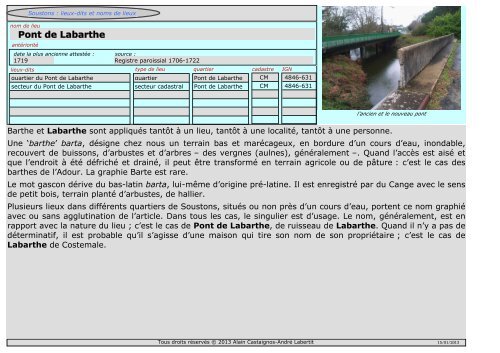Pont de Labarthe - Soustons : lieux-dits et noms de lieux
Pont de Labarthe - Soustons : lieux-dits et noms de lieux
Pont de Labarthe - Soustons : lieux-dits et noms de lieux
Create successful ePaper yourself
Turn your PDF publications into a flip-book with our unique Google optimized e-Paper software.
nom <strong>de</strong> lieu<br />
<strong>Soustons</strong> : <strong>lieux</strong>-<strong>dits</strong> <strong>et</strong> <strong>noms</strong> <strong>de</strong> <strong>lieux</strong><br />
<strong>Pont</strong> <strong>de</strong> <strong>Labarthe</strong><br />
antériorité<br />
date la plus ancienne attestée : source :<br />
1719 Registre paroissial 1706-1722<br />
<strong>lieux</strong>-<strong>dits</strong> type <strong>de</strong> lieu quartier cadastre IGN<br />
quartier du <strong>Pont</strong> <strong>de</strong> <strong>Labarthe</strong><br />
secteur du <strong>Pont</strong> <strong>de</strong> <strong>Labarthe</strong><br />
quartier<br />
secteur cadastral<br />
<strong>Pont</strong> <strong>de</strong> <strong>Labarthe</strong><br />
<strong>Pont</strong> <strong>de</strong> <strong>Labarthe</strong><br />
Barthe <strong>et</strong> <strong>Labarthe</strong> sont appliqués tantôt à un lieu, tantôt à une localité, tantôt à une personne.<br />
Une ‘barthe’ barta, désigne chez nous un terrain bas <strong>et</strong> marécageux, en bordure d’un cours d’eau, inondable,<br />
recouvert <strong>de</strong> buissons, d’arbustes <strong>et</strong> d’arbres – <strong>de</strong>s vergnes (aulnes), généralement –. Quand l’accès est aisé <strong>et</strong><br />
que l’endroit à été défriché <strong>et</strong> drainé, il peut être transformé en terrain agricole ou <strong>de</strong> pâture : c’est le cas <strong>de</strong>s<br />
barthes <strong>de</strong> l’Adour. La graphie Barte est rare.<br />
Le mot gascon dérive du bas-latin barta, lui-même d’origine pré-latine. Il est enregistré par du Cange avec le sens<br />
<strong>de</strong> p<strong>et</strong>it bois, terrain planté d’arbustes, <strong>de</strong> hallier.<br />
Plusieurs <strong>lieux</strong> dans différents quartiers <strong>de</strong> <strong>Soustons</strong>, situés ou non près d’un cours d’eau, portent ce nom graphié<br />
avec ou sans agglutination <strong>de</strong> l’article. Dans tous les cas, le singulier est d’usage. Le nom, généralement, est en<br />
rapport avec la nature du lieu ; c’est le cas <strong>de</strong> <strong>Pont</strong> <strong>de</strong> <strong>Labarthe</strong>, <strong>de</strong> ruisseau <strong>de</strong> <strong>Labarthe</strong>. Quand il n’y a pas <strong>de</strong><br />
déterminatif, il est probable qu’il s’agisse d’une maison qui tire son nom <strong>de</strong> son propriétaire ; c’est le cas <strong>de</strong><br />
<strong>Labarthe</strong> <strong>de</strong> Costemale.<br />
CM<br />
CM<br />
4846-631<br />
4846-631<br />
l’ancien <strong>et</strong> le nouveau pont<br />
Tous droits réservés © 2013 Alain Castaignos-André Labertit 15/01/2013
<strong>Soustons</strong> : <strong>lieux</strong>-<strong>dits</strong> <strong>et</strong> <strong>noms</strong> <strong>de</strong> <strong>lieux</strong><br />
graphie occitane normalisée<br />
<strong>Pont</strong> <strong>de</strong> Labarta<br />
notation phonétique API<br />
[punðələꞋβartə]<br />
Tous droits réservés © 2013 Alain Castaignos-André Labertit 15/01/2013


